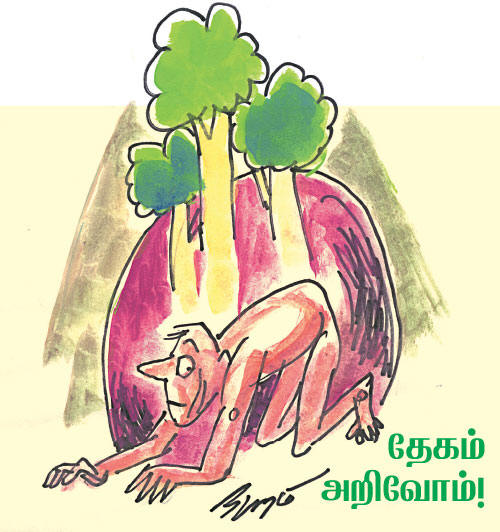ManCanBecomeGod08
We Know the Body!
P.N. Parasuraman
Images: Natanam
Just like clay can be made or molded into forms, the ignorant can be
made into men of knowledge and straight path. Persons with
half-knowledge do not accept no matter how convincing is the argument
and presentation. They are confused and confuse others.
Our situation is like that. We are now a little here and a little there.
The little we read or hear, we mix with the little we know and
immerse ourselves in the sea of confusion. If you eat a salty pudding
wantonly in the place of sweet pudding, it is of no use complaining
about it.
Likewise, thinking body is everything…There is nothing other than the
body: the pupil is roiled by holding that view and immersed in
confusion. To such a disciple, Guru began teaching.
“My disciple, you say there is nothing other than body (The
Śarīri
the soul being the hypostasis of Śarīra,
the body). If that is so, who is the he who had the dream-sleep?
You say, you had a deep sleep.
Who is he? Who is he
in the awake state? (Who is
he in the awake, dream-sleep and deep-sleep states?)
The disciple was immersed in thought.
He had a vague feeling of Dēhi
(Owner of the body) inside Dēham
(body). He felt that Dehi was the experiencer of the awake, the
dream-sleep and the deep-sleep states. To clear his vague feeling, the
disciple asked the Guru, “Swamy, please explain the true status of
Dehi.”
That disciple is none other than us! Body is important for all of us.
Accustomed to knowing the
utility of an object, we enjoy the object to the extent short of
endangering ourselves. Likewise, coming to know the usefulness of the
body, a precious object, we squeeze the sap out of it and extract the
work.
When the utility of an object is finished or beyond repair, we sell the
old utensils in the second-hand shop and get cash. There is no one to
come forward and buy the old decrepit body or even take it for free.
Hard work and abuse of the body at young age are the cause of a weak
body (in later years). We know to operate diligently cheap USB drives
and the card readers. The great tyranny is that we do not know how to
operate the priceless body with responsibility and probity!
We overwork and subject the eye, the ear, the nose, the mouth, the
intellect, the body… to a great stress. We stuff 500kg into a 5kg bag.
The result is the bag tears. Likewise, we stuff into our body
unnecessary things beyond its capacity, and suffer ill effects.
We do not seek refuge at the feet of a Guru and attain
mental clarity. We close our
eyes and grope in the dark room of ignorance. This article’s purpose is
to strike a match for a faint light to dissipate the darkness.
The disciple with body fixation asks the Guru to explain the true nature
and functions of Dēhi.
The guru answers as follows.
Kaivalliya Navanītham explains this entity with clarity and ease.
He explains the
distinctive marks of the body before he delves into those of Dēhi.
Why so?
Explaining the known to elucidate the unknown is an instructional
paradigm. Here is the analogy. The third day of waxing moon is not a
bright object in the sky. The saying goes, “See the third-day moon at
the tip of the nearer branch of the tree. Here the tree is an instrument
and not the conclusion. The third-day moon is important.” Likewise, the
teacher points to the cluster of the stars and says, “The dim star in
the cluster is Arundhati.”
In like manner, he tells us about the well-known gross body and its
Tattvas first before he asks us to get a Darśan of the particle (Dēhi)
within an atom.
தாலத்தின் மரங்கள் காட்டித்
தனிப்பிறை காட்டுவார் போல்
ஆலத்தின் உடுக்கள் காட்டி
அருந்ததி காட்டுவார் போல்
தூலத்தை முன்பு காட்டிச்
சூக்கும் சொரூபமான
மூலத்தைப் பின்பு காட்ட
முனிவரர் தொடங்கினாரே.
18
நார் ஊடு பணியாத் தோன்றல்
நரனாகத் தறியில் தோன்றல்
நீர் ஊடு கானல் தோன்றல்
- 20
Navanītham Verse 18.
Gurunāthar shows the easily visible gross (and graspable) body first and
later points to the subtle. To conceptualize an unseen object from
explication of a known object gives us the link. If you realize
Parabrahmam, the (one) creator of all, shining as the light of wisdom,
that gives Mukti (liberation). In the dark, the rope gives the illusion
of a snake. The log appears like a baby. In the day, the mirage appears
as distant water.
Kaivalliya Navanītham 20. If you realize these three (the rope, the log
and the mirage) and have an imprint in your mind, no problems will
arise.
When darkness lifts or the light shines, we realize, this is no snake
but a rope. The snake disappears and the rope appears in its place. Fear
dissipates. Likewise, the
darkness of ignorance envelopes us. We think of one as another and
entertain fear.
If that is so in darkness of ignorance, in the daylight, its appearance
and appeal are more interesting!
…continues…
